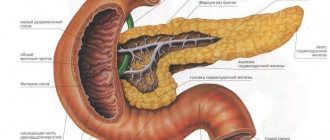What is pancreatitis
Pancreatitis is a disease in which an inflammatory process develops in the pancreas tissue. As the process progresses, the cells of this organ are gradually replaced by connective tissue, and the pancreas ceases to fully perform its functional duties.
There are two forms of this disease, which are essentially separate nosologies that have different causes and symptoms, as well as fundamentally different treatment methods. They are acute and chronic pancreatitis.
We will select and make an appointment with a doctor for free
Inflammation of the pancreas: everything you need to know about pancreatitis
Inflammation of the pancreas: everything you need to know about pancreatitis
Acute pancreatitis
Acute pancreatitis is a serious and extremely dangerous disease that requires immediate emergency medical care.
The most common cause is alcohol abuse, especially toxic substances that are used internally instead of regular alcoholic drinks (anti-ice, methyl alcohol, cologne, etc.), less often - errors in diet. Therefore, the vast majority of patients with acute pancreatitis are middle-aged men suffering from chronic alcoholism.
The essence of the disease is that areas of destruction suddenly appear in the gland tissue, that is, it dies irrevocably. In this case, the inflammation spreads beyond the organ: into the retroperitoneal space, tissue, omentum and ligaments of the liver. It begins to actively produce proteolytic enzymes, which have a toxic effect on the entire body.
In acute pancreatitis, the patient experiences severe pain in the upper abdomen, nausea, vomiting, stool disturbances, symptoms of intoxication, fever and sometimes jaundice of the skin.
The disease is treated in the surgical department of the hospital, sometimes doctors have to quickly remove the inflamed areas of tissue, carry out an inspection, install drainage, while at the same time they suppress the activity of the organ with medications and conduct massive infusion therapy. An important feature is that in acute pancreatitis, enzyme preparations are never prescribed.
Chronic pancreatitis
This form of the disease has nothing to do with acute pancreatitis. The main reason is constant errors in nutrition, abuse of spicy, fatty, fried foods, alcoholic and carbonated drinks, the presence of liver and gallbladder diseases (including the condition after its removal).
Chronic pancreatitis is common in both men and women. However, women between the ages of 40 and 50 suffer from it somewhat more often. Chronic pancreatitis has begun to appear even in teenagers, due to the abuse of fast food and soda.
Mezim for pancreatitis
Mezim for pancreatitis
The disease develops over many years. Often symptoms appear after dietary errors. Patients usually quickly figure out which foods cause unpleasant symptoms and try to avoid them.
The reason is that the production of enzymes that ensure the digestion of certain foods is reduced.
Therefore, 20-40 minutes after eating a person feels pain in the upper half of the abdomen, bloating, heaviness, nausea, and sometimes vomiting. Stool instability is manifested by alternating diarrhea with constipation. The disease is an alternation of episodes of exacerbation and remission, during which there are practically no symptoms or they are mild.
Treatment of chronic pancreatitis is carried out conservatively. After a complete examination, a general practitioner or gastroenterologist finds out which enzymes are produced in insufficient quantities and prescribes a drug for replacement therapy (Mezim, Festal, Creon, etc.).
It must be taken on the eve of meals, but if dyspeptic disorders persist, you can take another tablet. Other medications necessary to correct the functioning of the digestive system are also prescribed.
Omeprazole for pancreatitis
Omeprazole is an antisecretory drug. It blocks the production of hydrochloric acid by the lining cells of the stomach, which plays a vital role in the digestion process.
It is used for those diseases that are accompanied by increased acidity of gastric juice: hyperacid gastritis, peptic ulcer, gastroesophageal reflux disease, as one of the components of eradication therapy for Helicobacter pylori infection.
The instructions for use do not directly indicate that this drug is required for use in acute or chronic pancreatitis.
However, during the examination of patients with pancreatic pathology, the above diseases are very often detected.
They aggravate the course of acute and chronic pancreatitis, since this disrupts the process of both gastric and intestinal digestion. For this reason, these ailments very often accompany each other, and doctors prescribe Omeprazole in the treatment of pancreatitis.
The drug is available in three dosages: 10, 20 and 40 mg and two dosage forms - tablets and solution for intravenous administration. The form, dose and frequency of administration are chosen by the doctor based on the diagnosis, age and weight of the patient.
Prescription of Omez at various stages of the inflammatory process
Many patients ask the question “can I drink Omez for pancreatitis?” The drug has one useful feature that allows it to be used in both acute and chronic forms of the disease.
The drug works by rapidly combating painful sensations due to the fact that omeprazole has a suppressive effect on acidity and reduces intrapancreatic pressure. Thus, the pancreas is relieved of excessive load, the inflammation slowly goes away and normal operation is restored.
Omez for chronic pancreatitis first of all reduces the load on the pancreas and provides it with the most relaxed state.
It is important to note that pancreatitis has a lot of complications, one of which is gastroesophageal reflux disease. It occurs to the patient ten days after the development of the chronic stage of pancreatitis. The main reasons for the development of gastroesophageal reflux disease include:
- the stage when the motor function of the stomach and esophagus is impaired;
- the esophageal sphincter loses its ability to translate contents;
- the formation of a hiatal hernia along with increased stomach acidity.
The acidic environment that forms in the stomach passes into the esophagus, causing the patient to develop heartburn, pain in the chest area, in the navel area, leading to cough spasms with a sour taste in the mouth, and cases of dental caries often become more frequent.
The only correct solution to combat gastroesophageal reflux is the use of medications that have an anti-ulcer effect when the volume of hydrochloric acid is regulated. And the leader of this group is Omez, the advantage of which is a minimal list of side effects on the body. It is accessible and practical to use.
Omez for inflammation of the pancreas helps to cope with such unpleasant symptoms as:
- frequent abdominal pain;
- general weakness;
- constant dizziness;
- bloating in the intestines;
- feeling of dry mouth, belching, nausea;
- pressure surges, increased body temperature;
- vomiting attacks with the release of bile;
- unhealthy pale, sallow complexion, etc.
Complications of pancreatitis can be quite frightening and in order not to lead to diabetes mellitus and pancreatic cancer, it is necessary to immediately begin treatment with Omez.
Description of the drug
Omeprazole is a drug used to treat diseases of the pancreas and a number of other diseases of the gastrointestinal tract associated with the presence of ulcers. The main substance is omeprazole. Additional components of the product are glycerin, gelatin, water, sodium lauryl sulfate. The medicine is available in the form of tablets of 10, 20, 30 and 40 mg, depending on the concentration of the active substance.
The color of the tablets is white or red.
The dosage of the medicine is calculated individually depending on the patient’s diagnosis. The main effect of the drug is aimed at suppressing the production of gastric juice. The auxiliary effects of the drug are the reduction of inflammatory processes in the pancreas, relief of pain arising from ulcers or the entry of gastric juice into the organs of the gastrointestinal tract.
Omeprazole begins to act 1.5-2 hours after administration. The duration of the drug effect is up to 24 hours. The course of treatment is calculated individually depending on the patient’s diagnosis. After the patient stops taking this remedy for pancreatitis, the process of secreting hydrochloric acid by parental cells is restored after 4-6 days, depending on the individual characteristics of the body.
The drug is taken shortly before the main meal or with food. In case of severe manifestations of the disease, intravenous administration of the drug may be prescribed.
How to practice the effects of omeprazole
The instructions for the drug describe its use mainly in the upper lobes of the alimentary tract, which are associated with the production of gastric juice secretions.
It treats the following pathologies well:
- gastric erosions and ulcers;
- pancreatic fibroma;
- epigastric reflex;
- chancre in the duodenal region;
- bacterial inflammation of the intestines.
Pancreatitis is not on this list, and there are reasons for it. Before entering the pharmaceutical markets, the medicine has been studied for more than 10 years, the reaction is checked for each group of patients, tests are carried out for its safety and allergic reactions for compatibility with other antispasmodics.
Statistics are updated every year, and both positive and negative properties of sirocide are revealed.
This is where the question that worries everyone arises: is it possible to take the drug omeprazole everywhere, especially for pancreatitis?
The condition of the pancreas improved significantly after a trial use of the mixture: swelling decreased and pressure on the bile ducts decreased.
Inflammation and pain from pancreatitis have decreased, all thanks to this wonderful medicine. Now doctors everywhere use it in the practice of treating pancreas.
But in order to add pancreatitis to the list of diseases that omeprazole treats, pharmacists need to settle the documentary side of this issue.
Indications and contraindications for use
This is a universal drug used to treat various diseases and pathologies of the functioning of the pancreas. Omeprazole should be taken if the following indications exist:
- duodenal ulcer;
- the presence of an oncological neoplasm on the pancreas;
- acute and chronic form of pancreatitis;
- inflammation of the digestive system;
- peptic ulcer caused by pathogenic microflora entering the body.
Omez can be taken for pancreatitis and other diseases of the gastrointestinal tract only with the permission of the attending physician, since the drug has many contraindications. It is strictly forbidden to use the medicine during pregnancy and breastfeeding. Main contraindications to taking the drug:
- sleep problems;
- frequent headaches, attacks of dizziness;
- stool disorders;
- psychical deviations;
- dysfunction of the central nervous system;
- infectious skin diseases;
- swelling of soft tissues.
Before using the drug, you must carefully read the instructions for use, since the patient may have individual intolerance to certain components of the drug. You need to drink the product in the exact dosage prescribed by your doctor.
It is forbidden to independently extend the duration of taking the drug, as an overdose is possible, which manifests itself in a severe symptomatic picture and often causes death. Among the most common side effects that occur during long-term use of the drug is dry mouth.
If the manifestation of this symptom is moderate, there is no cause for concern. If the patient experiences a strong feeling of discomfort, it is necessary to consult a doctor so that he can adjust the dosage of the drug.
In the presence of liver diseases and pathologies, long-term use of Omeprazole can provoke the development of jaundice. In rare cases, due to the individual characteristics of the body, inflammation of the kidneys develops.
Diagnostics
- Hemogram, this method shows an increase in ESR, platelets and leukocytes, most often this occurs during inflammatory processes with purulent manifestations, as well as when there is a suspicion of cancer.
- Biochemical analysis of blood and urine. These studies should show if there are disturbances in the pancreas: an increase in elastase-1, lipase, blood trypsin or urine amylase. Such indicators occur during the inflammatory process. And with the loss of gland cells, that is, its death, most often associated with oncology: it reduces all these enzymes.
- Coprogram. This is a stool test that can show that fats and proteins are not being digested.
- Fecal elastase-1 study. If the level of this enzyme decreases, then the specialist can identify malignant tumors, complex pancreatitis, and other abnormalities in the patient in the early stages.
- Tumor markers. They will talk about whether there is death of tissues and cells of the pancreas against the background of developing oncology.
- Tests for pancreatic enzyme deficiency. Such tests include: Lund's test, with methionine, bentyramine, with mecholyl ether, pancreatolauric test.
- Glucose tolerance test or starch load test. This test helps to show disturbances in the production of the very important hormone insulin.
After all the studies have been completed and the tests are ready, the specialist prescribes therapy using medications, including Omeprazole for pancreatitis and a diet, which includes table No. 5.
1pankcreatit.ru
Application
Before taking Omez, you should consult a doctor. The dosage and course of treatment are selected individually. For exacerbations of peptic ulcer disease, the drug is taken once a day in the morning. The capsule of the medicine is swallowed whole, washed down with water.
The duration of treatment is 2 weeks. If there is no positive dynamics from taking the medication or is weakly expressed, the course is extended for another 2 weeks, but only the attending physician can decide on extending the medication.
In patients diagnosed with reflux esophagitis and the presence of inflammatory processes in the gastrointestinal tract, the course of treatment is 5 weeks. In severe stages of the disease and an intense symptomatic picture, the duration of treatment is 2 months.
In case of long-term use, individual dosage adjustment is necessary.
If the duodenum is damaged by an ulcerative process with very slow healing, you can take Omeprazole once a day. The course of treatment is 1 month. If ulcer symptoms reappear after treatment, a repeat dose is prescribed with the minimum dosage. It is possible to use the drug for the purpose of prevention in severe cases of ulcers with a minimum dosage of the drug, taken once a day.
For peptic ulcers, treatment takes 30 days; in case of slow formation of scars on the tissue, the course of taking the drug must be extended for another 1 month. For peptic ulcers, Omeprazole is prescribed for up to 2 weeks to suppress the activity of pathogenic microorganisms. If the scarring process is too slow, the duration of treatment is extended for another 2 weeks.
Combination of drug groups with omeprazole
The interaction of omeprazole with drugs by group is determined by the quality of the body’s absorption of drugs.
Cardiac medications in combination with omeprazole, namely digoxin or warfarin, can reduce its capabilities.
As a result, the dosage of omeprazole will have to be reconsidered. Clopidogrel is also not the best combination for the drug, because it loses its properties when interacting and can cause thrombosis.
A representative of the antifungal group, intraconazole, when taken together with omez, loses its medicinal properties and is poorly absorbed, so it is better not to experiment.
The neurological anticides phenytoin and diazepam in a single dose become sharply concentrated and lose their antiepileptic properties.
It is necessary to change the dosage and adjust the prescription by a gastroenterologist.
Spectral combination with antiretroviral drugs entails multiple inflections in one direction or another.
Thus, ritonavir becomes highly diluted, and nelfinavir, on the contrary, increases its effect significantly.
Omeprazole combines well with metronizadol and amoxicillin, but it increases the pharmacological properties of clarathromycin.
Contraceptives and drugs such as theophylline, diclofenac and piroxicam do not cause side effects with the drug.
The ethyl alcohol content in alcohol has a negative effect on pancreatic disease. But with omeprazole, alcohol has no negative properties.
The question of whether it is possible to take omeprazole if you have an illness, like a first aid vaccine, is brushed aside by itself.
The drug quickly localizes pain, reducing inflammatory formations, and also contributes to reduced production of gastric juice.
It is known to use the drug in almost all applications of diseases of the gastrointestinal tract, which only increases its popularity.
Taking medication for pancreatitis
Omeprazole has a wide spectrum of action, but the main purpose of the drug is the treatment of pancreatic diseases and relief of their symptomatic picture. The course of use of the drug depends on the form in which pancreatitis occurs - chronic or acute.
In case of acute pancreatic disease, the drug is taken once a day, if possible in the morning before breakfast or during the morning meal. The capsule is swallowed whole and washed down with plenty of water. The duration of use is 14 days; if necessary, the doctor will prescribe another course of treatment.
In case of relapse of pancreatitis, Omeprazole is taken in an increased dosage without reference to the time of day, but if possible before or during meals. The duration of treatment is 30 days.
If the inflammatory process is stopped very slowly, repeated therapy is prescribed, but with a decrease in the initial dosage.
For chronic pancreatitis, the maximum dosage of the drug is prescribed. Drink 1 capsule per day, in the morning, with plenty of water. If the symptomatic picture is suppressed very slowly, the dosage of the medicine is reduced, the amount taken per day is increased to 2 capsules. Data are averaged. Before prescribing the amount of medication and the duration of its use, the patient must undergo a medical examination.
If chronic pancreatitis worsens, this always entails severe symptoms and a long course of the disease. In such cases, the doctor prescribes an increased dosage of the drug. The duration of treatment is individual, therefore the patient periodically needs to undergo a medical examination in order to track the positive dynamics of taking the medicine.
During treatment, the patient must adhere to a strict diet. In case of severe clinical manifestations of exacerbation of chronic pancreatitis, the drug Omeprazole is recommended to be combined with other medications.
Reviews from patients who have already undergone treatment with Omeprazole confirm the positive effect of the drug on the digestive system. In the presence of chronic stage pancreatitis, it is recommended to take the drug for preventive purposes.
In combination with a therapeutic diet, the remission process can be extended for as long as possible. The drug can be taken only after prescription by the attending physician. If your health condition worsens due to long-term use of the drug, it is necessary to reduce the dosage of the drug or change the drug.
Compatible with medications and alcoholic beverages
Experts note the excellent combination of omeprazole with other pharmaceuticals.
His merit in the treatment of pancreatitis and pathological ulcerative diseases deserves special mention. But still, if the patient, in addition to this medicine, also takes an additional series of tablets, then this should be reported to the doctor.
In combination with certain groups of drugs, ziracid can enter into a Rh conflict. There have been no negative reports of its effect on driving while driving.
The capsules can be taken with food, and if the packaging itself is irritating, then it is quite acceptable to pour its contents into a plate and mix with some drink or fermented milk product.
The result is a kind of suspension that is not at all difficult to swallow.
Positive indications for the combined use of antacids and omeprazole were noted. Medicines such as ethanol, lidocaine, caffeine, diclofenac and metoprolol have no contraindications and can also be combined with capsules.
An interesting experience of taking tablets with clarithromycin causes the tongue to turn black, due to the fact that the zeracid does not allow the drug to be absorbed, which has a bioavailability pH level.
After completing the course, the color of the oral cavity returns to normal.
Reviews about the drug
Patients who treated pancreatitis with Omeprazole say:
- Elena, 37 years old: “I have been suffering from pancreatitis for a long time. During an exacerbation, I take a large amount of medicine, but after a while terrible pain, vomiting, and all other unpleasant symptoms occur again. I started taking Omeprazole as prescribed by the doctor. I’ve been taking the medicine not long ago, but the pain has already decreased and I feel much better.”
- Maxim, 44 years old: “Chronic pancreatitis requires constant medications and denial of many favorite foods. I started taking Omeprazole and things got much better. Now I drink it periodically for preventive purposes, I undergo regular medical examinations, and so far I have managed to put the disease into stable remission.”
- Angela, 39 years old: “I bought Omeprazole for my husband, who has been suffering from pancreatitis for many years. At first I took it myself, complained of dry mouth, and had to see a doctor to adjust the required dose. The side effects disappeared, as did the unpleasant symptoms of pancreatitis, and all thanks to the drug.”
Omeprazole is a broad-spectrum drug that successfully fights diseases of the gastrointestinal tract accompanied by ulcerative formations or inflammatory processes. The remedy is most effective in the treatment of pancreatic disease - pancreatitis, quickly stopping the inflammatory process, reducing pain and other unpleasant symptoms.
There are many people suffering from diseases of the gastrointestinal tract. Inflammation of the pancreas is diagnosed annually in 52 thousand people in Russia. Its treatment involves taking various medications. Omeprazole for pancreatitis is one of the first drugs that has a beneficial effect on the entire functioning of the digestive system.
Treatment of cholecystitis and pancreatitis
In addition to inflammatory changes, these diseases lead to the fact that enzymes enter the intestines in insufficient quantities, resulting in malfunctions in the digestive system. Without timely and competent treatment, serious complications can arise, for example, stomach diseases, liver diseases, and type 2 diabetes mellitus.
How to treat pancreatitis and cholecystitis as a joint disease is determined by a gastroenterologist. Treatment usually involves taking different medications:
- Gordox and contrical inactivate enzymes and compensate for pathogenesis;
- metabolic drugs (pentoxyl and methyluracil) inhibit the effect of trypsin on tissue;
- analgin and baralgin relieve pain;
- cimetidine and omeprazole suppress the acidity of gastric juice;
- enzyme preparations (pancreatin, festal) eliminate insufficiency of external secretion.
With cholecystitis, it is necessary to relax the contracted bile ducts and eliminate pain. For this, no-shpa, buscopan, papaverine, and motilium are prescribed. If the gallbladder is excessively relaxed and is not able to contract to release bile, there is a need for drugs such as cisapride, eglonil. Choleretic agents enhance the production of bile: lyobil, holagol, holosas.
Antibiotics for cholecystitis and pancreatitis
For pathologies such as cholecystitis and pancreatitis, treatment with antibiotics is a rather controversial issue. This is due to the fact that these drugs provide a clear therapeutic effect, but can also cause systemic pathological changes.
If the patient has chronic pancreatitis and cholecystitis, antibiotics are prescribed intramuscularly or intravenously for maximum effect. For each patient, the optimal number of injections and their frequency are determined individually. Typically, injections are given about three times a day for seven or ten days.
Tablets for pancreatitis and cholecystitis are prescribed in mild cases. Broad-spectrum antibiotics (sigmamycin, tetracycline, rifampicin, oletethrin) are usually used.
Numerous studies have shown that addiction to the effects of antibiotics develops very quickly. As a result, they can no longer eliminate the negative effects of pathogenic organisms during attacks.
Preventative use of antibiotics can have a detrimental effect on the body. Due to the suppression of the immune system, it loses the ability to effectively resist infections. As a result, more and more doctors are inclined to believe that antibiotics for cholecystitis and pancreatitis should be prescribed only during attacks.
General recommendations
Treatment of chronic pancreatitis and cholecystitis with medications cannot be interrupted independently, even if there are signs of significant improvement. The result of such a rash step can be a deterioration of the condition and even complications. Only the attending physician determines how long you need to take medications for pancreatitis and cholecystitis and in what quantities. It is the patient's responsibility to carefully follow the recommendations received.
Treatment of cholecystitis and pancreatitis with medications must be supplemented with diet. It is necessary to eat only light foods that are digested quickly and do not overload the gastrointestinal tract.
doc.ua
Indications for use
Gastroenterologists always recommend taking Omeprazole for pancreatitis. In addition, there are many other diseases of the gastrointestinal tract (gastrointestinal tract), for which the use of a “universal” drug is indicated:
- peptic ulcer of the stomach and duodenum;
- inflammation of the gastric mucosa in acute or chronic form caused by Helicobacter pylori infection;
- pathological reflux of gastric contents into the esophagus (esophagitis-reflux);
- inflammation of the gastric mucosa while taking NSAIDs (non-steroidal anti-inflammatory drugs);
- after operations on the digestive organs in order to prevent acid from entering the respiratory system;
- combinations of gastric ulcer and benign formation.
Most often, it is enough for patients to take the drugs orally. Only in rare and severe cases is intravenous use of Omeprazole allowed.
Release form and how to take
Omeprazole is available in powder and tablet form; this substance is white in color. The dosage of this drug during treatment of pancreatitis should be selected by a specialist. Since it has a direct dependence on how large the secretion of stomach acid is.
This drug very actively fights against high acidity at any time of the day. The medicine begins to work two hours after it enters the human body and its effect lasts for a day. It is used orally during meals, but there are cases when Omeprazole is administered intravenously for pancreatitis.
How does the drug affect the pancreas?
Pancreatitis is a lesion of the pancreas, in which its enzymes cannot enter the duodenum, but are retained in the organ and gradually destroy it. In addition, all the resulting toxins enter the blood, heart and lungs, and kidneys. This poses a considerable danger to the entire body.
It would seem that Omeprazole is a drug that reduces the secretion of hydrochloric acid. What effect can it have on the pancreas? He:
- reduces pain in the epigastric region;
- effectively removes accumulated enzymes in the gland;
- reduces swelling of inflamed tissue;
- reduces pressure in the ducts of the duodenum 12;
- maintains the necessary alkaline environment at a normal level in the duodenum;
- reduces the inflammatory process;
- regulates metabolic processes.
Dosage for pancreatitis
Before taking any pills on your own, you must first consult with a specialist. After all, the course and dosage are prescribed based on the stage, form and severity of the disease.
| Form of the disease | Required dosage of the drug |
| Acute | 20 mg in the morning 1 time per day. Duration of therapy – 2 weeks |
| Exacerbation stage | 40 mg before meals 1 time per day. Duration of treatment – 4 weeks. For exacerbation of pancreatitis, 10 mg 1 time per day. For prophylaxis 20 mg 1 time per day |
| Chronic | 60 mg 1 time per day before meals in the morning. In severe cases, the dose of the drug is doubled and divided into 2 times (morning and evening) |
The drug instructions also contain an average dosage, but you should not rely on these data. The duration of the course and dosage is determined only by a gastroenterologist.
Contraindications for use
Omeprazole is considered a very strong drug, but many people think that it can be taken by everyone indiscriminately. Unfortunately, it is not. Like all medicines, this has a number of contraindications:
- period of gestation (the drug is able to penetrate into the blood through the placenta);
- lactation (passes into breast milk and may adversely affect the health of the infant);
- individual intolerance to the components of the medication;
- children under 12 years of age;
- headaches and dizziness;
- central nervous system disorders and mental illnesses;
- infectious skin diseases;
- severe diarrhea (repeated).
Persons with a history of kidney or liver disease should definitely consult a doctor, who will determine how much the effect of the prescribed treatment exceeds the potential risk to the patient’s health.
Taking Omeprazole may distort the result of scanning for the presence of neuroendocrine malignancies, so you must stop taking the drug 3-4 days before the expected examination.
Side effects
Despite its positive effects, the drug has a number of negative consequences that may appear in the patient after starting use.
| System | Unpleasant sensations |
| Digestive | Nausea, vomiting, stool disorder, increased gas formation, feeling of fullness in the abdomen, stomatitis in the oral cavity, candidiasis of the stomach and intestines, liver failure, yellowish coating on the tongue, bitter taste in the mouth and severe thirst, hepatitis |
| Central nervous | Headaches, dizziness, numbness of the hands and feet, depression or hyperactive behavior, drowsiness or insomnia, impaired activity of the optic nerves, hallucinations, delirium, hypersecretion of sweat glands |
| Musculoskeletal system | Severe muscle pain and aching joints, fatigue after minor physical exertion, back pain |
| Blood | A sudden decrease in the level of white blood cells and platelets in the blood, as well as a change in the number of red blood cells |
| Respiratory | Bronchospasm |
| Immune | Various swelling of the mammary glands, allergic manifestations: edema, sudden changes in body temperature, Quincke's edema (angioedema) |
| Skin of the body and head | Severe hair loss, skin rashes, itching, urticaria, ultraviolet intolerance |
In rare cases, kidney disorders may occur, which are accompanied by inflammation and swelling of the soft tissues.
Side effects of the drug
Omeprazole for the treatment of pancreatitis is not suitable for all patients. In several cases it can cause side effects:
- Dermatological signs: itchy rash, hair loss, hypersensitivity to ultraviolet radiation.
- Musculoskeletal system: painful manifestations of joints and muscles, weakness, fatigue.
- Nervous department: profuse sweating, depression, migraines, increased activity.
- Hematopoietic system: thrombocytosis and leukocytosis.
- Digestive tract: abdominal cramps, vomiting, nausea and diarrhea, rarely there is a change in taste buds resulting in bitterness and dryness.
- Allergic crisis: body temperature changes sharply, mammary glands are enlarged, limbs swell.
Despite its effectiveness in combating pancreatitis and other gastrointestinal diseases, omeprazole can cause persistent intolerance.
As soon as one of the above signs appears instead of improvement, you should immediately contact a gastroenterologist.
Analogs
Any medicine has many analogues, which differ from each other in price and additional components. Omeprazole has many similar drugs that have the same positive effect on the digestive tract.
The most common of them are:
- Omeprazole Stada - inhibits hydrogen-potassium adenosine triphosphatase in the parietal gastric cells and blocks the last stage of the formation of hydrochloric acid.
- Gastrozol - helps in the treatment of gastric and duodenal ulcers, is a prevention of acid aspiration syndrome and dyspeptic syndrome while taking medications.
- Omez - inhibits the production of hydrochloric acid, reduces irritation of the stomach walls, regardless of the type of irritant.
- Ultop – reduces the secretion of hydrochloric acid, normalizes its activity.
- Bioprazole – has an antiulcer effect, reduces the secretory activity of gastric juice.
- Losek MAPS - when taken together with antibiotics, quickly relieves the symptoms of the disease, promotes rapid regeneration of damaged tissues, ensures stable remission and significantly reduces the risk of gastrointestinal bleeding.
The duration of therapy depends on the form and severity of the disease and can vary from 2 weeks to a month
All drugs similar to regular Omeprazole are available in capsule form. Is it possible to take substitutes for pancreatic diseases? Yes, you can, but you must first discuss all the nuances with your doctor. The dosage of medications during treatment is also 20 mg in the morning.
How does omeprazole work?
This is a new generation medication that does an excellent job of eliminating obvious signs of the disease.
Once in the body, omeprazole is modified by metabolism, and has a qualitative effect on the pain point when accumulated up to the 5th day of administration.
At the same time, taking it for a long time, painful organs are stabilized without causing addiction or dependence.
In fact, this drug is a kind of filter that significantly reduces the acidity of gastric juice, which in turn produces an enzyme harmful to the body - hydrochloric acid.
The medication contains elements that are derivatives of benzimidazole. The more omeprazole is in the body, the stronger its healing effect.
Omeprazole is sold in the form of capsules in a shell, which quickly dissolves into the stomach secretions.
The contents of the capsule are crystalline powder, but there are analogues for intravenous use.
The powder, dissolving, begins to act, eliminating epigastric pain, and significantly reduces the volume of gastric juice by up to 50%, significantly reducing acidity.
The dosage in tablets is prescribed by a qualified specialist, and how to take the medicine directly depends on the severity of the disease.
Should be taken 10 minutes before or during a meal. The drug dissolves within 24 hours, and the effect can be noticed after 1 hour. After some time, the drug begins to have a stronger effect.










